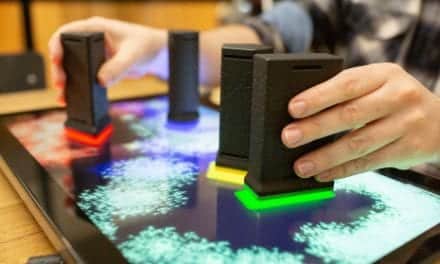A new portable arm rehabilitation robot aims to help patients carry out robot-aided therapy at home, allowing them to perform intensive exercises without visiting hospitals or clinics, which can possibly reduce the risk of exposure to infectious diseases such as COVID-19. The robot can also be used in hospitals and outpatient facilities such as nursing homes and clinics, according to researchers.
The compact robot, known as the H-Man, has demonstrated its efficacy in helping patients improve their upper-limb mobility in a clinical trial involving 60 stroke patients undergoing rehabilitation therapy. The study is published in the Journal of Rehabilitation and Assistive Technologies Engineering.
The H-Man weighs 14 kgs and can be placed on a normal table. Consisting of a handle shaped like a joystick and a large screen, the patient performs prescribed tasks shown on the screen such as playing a game, while the robot evaluates his or her progress and sends feedback to therapists wirelessly, according to a media release from Nanyang Technological University.
The smart robot was developed over 8 years by scientists from Nanyang Technological University, Singapore (NTU Singapore) in collaboration with rehabilitation physicians and occupational therapists from the Centre for Advanced Rehabilitation Therapeutics (CART) at Tan Tock Seng Hospital (TTSH) Rehabilitation Centre.
According to the leader of the NTU research team, Associate Professor Domenico Campolo, co-founder of ARTICARES, their initial aim was to develop an affordable and portable robot that post-stroke patients could use for rehabilitation therapy at home or in community-based settings at their own pace with minimal supervision, as a complement to conventional therapy.
“The machine targeted smart intensive, training to help stroke patients regain sensorimotor control and strength, and translate these to functional use of their arms in combination with conventional therapy by occupational therapists.
“Furthermore, lasting gains up to 19 weeks were observed after training, implying sustainability of the training and this was associated with high levels of patient safety and self-reported satisfaction in trained subjects. Potential to upskill rehabilitation professionals and enhance their productivity are also plus points to use robots in the clinic.
— Adjunct Associate Professor Karen Chua, Senior Consultant at the Department of Rehabilitation Medicine, TTSH and at NTU’s Lee Kong Chian School of Medicine, who led the clinical trials for the H-Man from 2014 to 2018
Enabling Continued Rehabilitation
“For post-stroke or brain injury patients, it is challenging for them to make the journey from home to hospital and back, so they often require a family member or helper to assist them.
Our hope is that the H-Man robot can help bridge this gap by allowing them to do therapy in the nearby day rehabilitation center, clinic or even at home, since we have clinically demonstrated its therapeutic efficacy and safety.”
— Chief Executive Officer and co-founder of ARTICARES, Dr Asif Hussain
In the clinical trials, patients using H-man successfully improved in their mobility at the same rate as conventional therapy. An assessment of their Fugl-Meyer Assessment (FMA) scores showed an average increase over 6 weeks of training of 46% for H-Man compared to conventional therapy and long-term retention of learning observed at follow-up stage with FMA was also on average observed to be 20% higher. Four of the subjects, successfully trained with the H-Man in their own home for 3 days, this time, under the supervision of their carers, the release continues.
How the H-Man Works
Specially designed games for helping patients stay motivated and learn in a fun way are displayed on the H-Man screen. Patients play the games using a joystick-shaped handle that can sense the patient’s arm strength and increase or decrease the difficulty of performing tasks in a lot of different therapeutically beneficial ways, based on the patient’s individual needs, thus helping them to relearn sensorimotor control and apply it to activities for daily living.
To control the games and programming on the H-Man, a digital platform called CARE has been designed based on inputs and feedback from TTSH rehabilitation physicians and occupational therapists. An automatic reporting feature also allows clinicians to track their patients’ recovery remotely.
Moving forward, ARTICARES plans to further harness technologies such as robotics and AI to improve healthcare delivery and to improve the lives of people.
[Source(s): Nanyang Technological University, News Medical Life Sciences]
Related Content:
Telemedicine-Delivered Arm Rehab Results on Par with In-Person Clinic
Get ‘Connect’-ed to Rehab the Hands and Arms Post-Stroke
Telerehab vs In-Clinic: Which One Wins the Post-Stroke Arm Weakness Battle?





